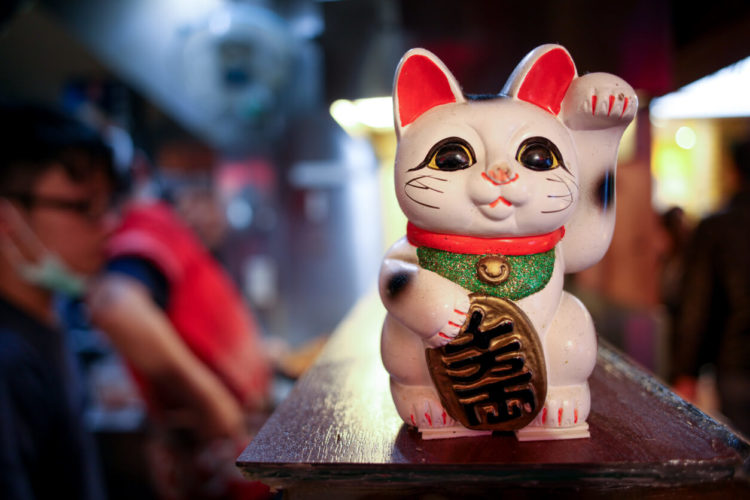If you’ve ever ventured out into your city’s rendition of Chinatown or just been struck with the insatiable need for sushi, you may be familiar with the iconic Lucky Cat statue. Almost every Japanese family-owned business has this cheerful kitty displayed somewhere. In Japan, there are even shrines dedicated to these little guys! Indeed, it’s more than just a fun decoration. There is a rich history surrounding this lucky little kitty friend, and today, we’re going to learn why.
Talk to the Paw: Lucky Cat Variations
While each statue may have its own unique style and variation, there are a few important aspects of each one that gives it that Lucky Cat authenticity. The most popular rendition of the Lucky Cat is the mostly-white calico Japanese bobtail kitty raising her paw and holding a gold coin, which commonly reads “sen man ryou”, the Japanese characters for “10 million gold coins”. Additionally, she may be wearing a collar with a little bell with the Japanese word “fuku” inscribed on it, which means “luck”.

There have certainly been many other variants of the Lucky Cat; some are black, some are gold, some have the left paw raised, some have the right paw raised, and some others have both paws raised. These may seem like negligible alterations, however, each detail holds a different significance. For instance, if the left paw is raised, that is meant to welcome guests into the home or customers into a business establishment. If the right paw is raised, this is meant to usher in good fortune and luck with money. If both little paws are reaching up into the air, this is meant to offer protection. Just like with the paws, the color of each cat has a special significance as well. Black cats are meant to ward off evil spirits or people with malintentions, gold kitties are meant to bring wealth, and red cats are meant to offer either love and romantic success or health and vitality, specifically to children.
Japanese Culture
The word “maneki-neko” literally translates to “beckoning cat”. Some Westerners seeing the Lucky Cat for the first time may instinctually be inclined to suggest that our lucky little buddy is waving to say hello – especially if what they’re seeing is one of the battery-operated or solar-powered kitties with their little arms reaching back and forth on a loop. However, in Japan, this motion is meant to be one of beckoning and calling someone towards them. Like, “come on in! It’s really great in here. There are cats!” I’d be sold instantly. Wouldn’t you?
The Japanese lucky cat is such a pervasive image in Japanese culture that it’s almost synonymous with Japan itself. But why is the Lucky Cat… well, a cat? Why not a dog or a horse or a llama? Well, as you may remember from a previous article of mine, cats have made quite a name for themselves over the history of, well, forever – and Japan is no exception. In Japanese culture, cats are revered as an omen of good luck. Of course it stands to reason, then, that the most popular good luck charm would feature a feline!
History of the Lucky Cat
The maneki-neko is thought to be dated all the way back to 1852 during the Edo period of Japan. As such, the Lucky Cat was originally named “Edo”. Pretty fitting, eh? In 1876, a shrine in Osaka began selling little maneki-neko figurines wearing little kitty kimonos as good luck charms. How cute is that!? Only in Japan could one hope to find such joy and whimsy. By the turn of the century, maneki-nekos were gaining popularity fast, and pretty soon, almost every business establishment kept the Lucky Cat statues in their windows.

However, there is another anecdote about how the Lucky Cat came to be. According to legend, the second lord of Omi-Hikone, named Ii Naotaka, took refuge from a thunderstorm in a temple. It was a cat, he claimed, who offered him a respite from the weather and invited him into the temple. In order to pay his respects to the cat who had helped him and express his appreciation, he dedicated the temple to his clan. Later, this temple would be known as the Gotokuji Temple – a place you can still visit in Japan to this day! Since the dedication of Ii Naotaka, the temple has flourished and is called the “Fortune-Inviting Kannon”. Many tourists still visit this place for its beauty, history, promise of good fortune, and – you guessed it – Lucky Cat statues.
So, what do you think? Are you feeling lucky? Next time you’re caught in a thunderstorm, keep your eyes peeled. There might just be a generous kitty somewhere, ready to give you shelter and good fortune!







